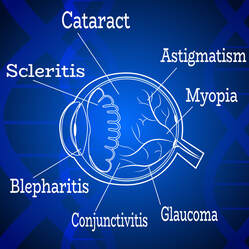Idiopathic intracranial hypertensionIdiopathic intracranial hypertension occurs when increased pressure around the brain leads to vision changes. It develops when the cerebrospinal fluid builds up in the skull. The high pressure in the skull puts pressure on the optic nerve and can lead to visual changes. Symptoms: Symptoms of idiopathic intracranial hypertension include:
Cause: Idiopathic indicates the cause is not known. But obesity appears to be a risk factor for developing the condition. Treatment: Treatment may include weight loss for those that are obese. According to the National Eye Institute, losing even 10 percent of body weight may decrease symptoms. Additional treatment may include medication to decrease cerebrospinal fluid production. Surgery may also help and includes placing a shunt to drain extra fluid. Behcet’s DiseaseBehcet’s disease involves a condition that damages the blood vessels in different parts of the body. In some cases, the vessels in the eyes can become damaged. Symptoms: When Behcet’s disease affects the eyes, symptoms may include:
Causes: Behcet’s disease occurs due to inflammation in the blood vessels from an abnormal response by the immune system. Doctors are not sure why it may occur. A combination of genetics and environmental issues may trigger the condition. Treatment: Treatment is aimed at decreasing inflammation. It usually includes steroids and medications to decrease the immune system response. RetinoblastomaRetinoblastoma is an uncommon type of cancer that affects the retina. According to the American Cancer Society, retinoblastoma is most common in children under two. Symptoms: Retinoblastoma symptoms may develop in one or both eyes. Usually, symptoms include:
Causes: Researchers think that in many cases, retinoblastoma develops due to a genetic mutation. The gene RB1 has been identified as a cause of retinoblastoma. But only about 1 out of 3 children with retinoblastoma have the gene mutation. The cause of the other cases is not clear. Treatment: The treatment for retinoblastoma often involves surgery to remove the tumor. Treatment may also include radiation therapy, chemotherapy, and laser therapy. The exact treatment plan depends on whether cancer has spread beyond the outside of the eye. Retinitis pigmentosaRetinitis pigmentosa involves a group of uncommon eye diseases that affects the retina. The diseases cause the retina to break down gradually over time. This deterioration of the retina eventually leads to vision loss.
Symptoms: The symptoms of retinitis pigmentosa often start in childhood and may include:
Causes: The cause of retinitis pigmentosa is not clear, but it appears to be a genetic condition that people are born with. Symptoms may start at any age, but they typically begin in childhood. Unfortunately, most people with retinitis pigmentosa lose their sight. Treatment: According to the American Academy of Ophthalmology, currently, there is no cure for retinitis pigmentosa. Using low vision aids may help with adjusting to the condition. If you have any questions about rare eye diseases or any other eye condition, we are happy to help. Also, if you would like to ask whether an appointment with one of our eye doctors would be appropriate at this time, call our office at 508-746-8600. Comments are closed.
|
EYE HEALTH BLOGCategories
All
Archives
July 2024
|
|
Kadrmas Eye Care New England
55 Commerce Way, Plymouth, MA 02360
14 Tobey Road, Wareham, MA 02571 133 Falmouth Road (Rt 28), Mashpee, MA 02649 |
Phone Number:
1-508-746-8600 Hours: Monday through Friday — 8 AM – 4:30 PM |


 RSS Feed
RSS Feed
